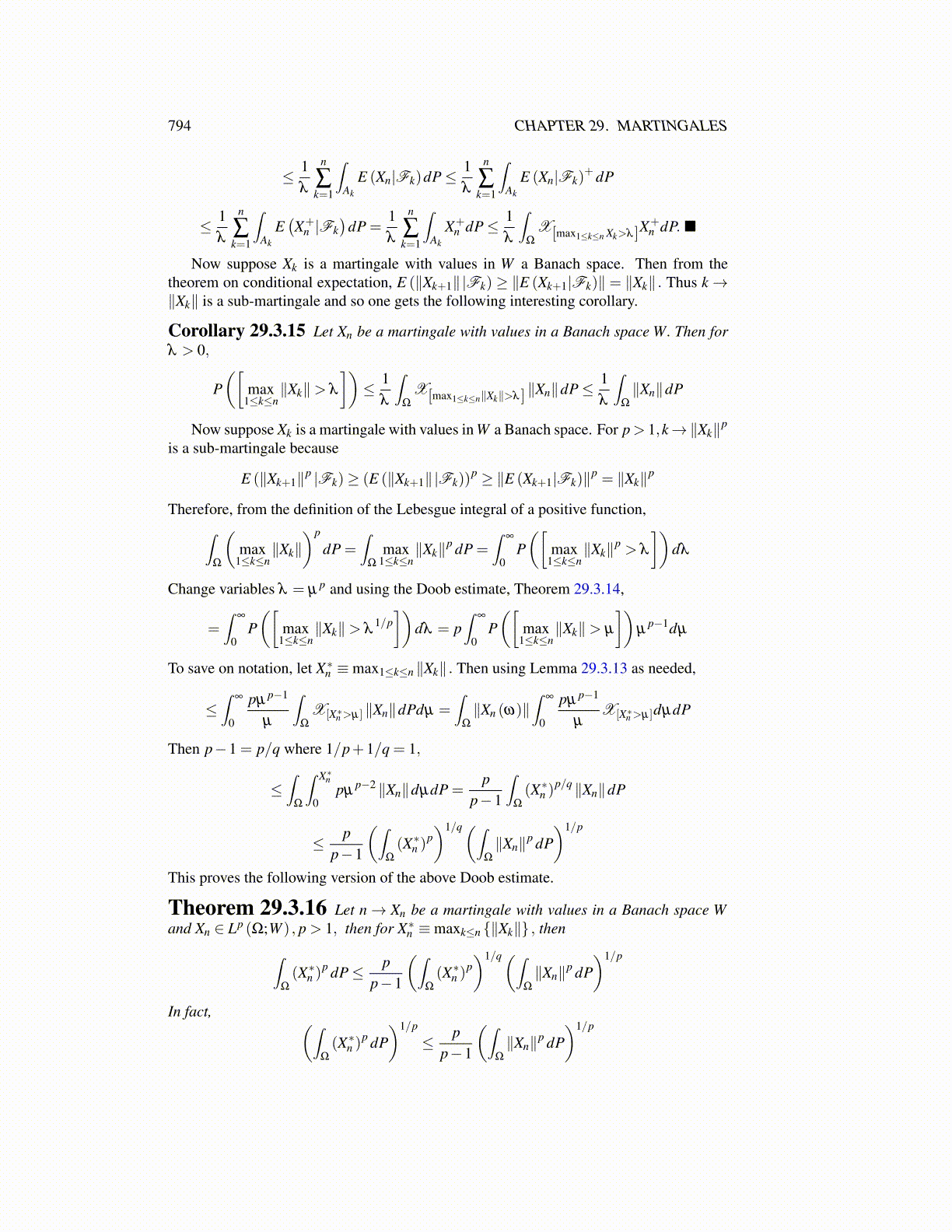
794 CHAPTER 29. MARTINGALES
≤ 1λ
n
∑k=1
∫Ak
E (Xn|Fk)dP≤ 1λ
n
∑k=1
∫Ak
E (Xn|Fk)+ dP
≤ 1λ
n
∑k=1
∫Ak
E(X+
n |Fk)
dP =1λ
n
∑k=1
∫Ak
X+n dP≤ 1
λ
∫Ω
X[max1≤k≤n Xk>λ ]X+n dP. ■
Now suppose Xk is a martingale with values in W a Banach space. Then from thetheorem on conditional expectation, E (∥Xk+1∥|Fk) ≥ ∥E (Xk+1|Fk)∥ = ∥Xk∥ . Thus k→∥Xk∥ is a sub-martingale and so one gets the following interesting corollary.
Corollary 29.3.15 Let Xn be a martingale with values in a Banach space W. Then forλ > 0,
P([
max1≤k≤n
∥Xk∥> λ
])≤ 1
λ
∫Ω
X[max1≤k≤n∥Xk∥>λ ] ∥Xn∥dP≤ 1λ
∫Ω
∥Xn∥dP
Now suppose Xk is a martingale with values in W a Banach space. For p> 1,k→∥Xk∥p
is a sub-martingale because
E (∥Xk+1∥p |Fk)≥ (E (∥Xk+1∥|Fk))p ≥ ∥E (Xk+1|Fk)∥p = ∥Xk∥p
Therefore, from the definition of the Lebesgue integral of a positive function,∫Ω
(max
1≤k≤n∥Xk∥
)p
dP =∫
Ω
max1≤k≤n
∥Xk∥p dP =∫
∞
0P([
max1≤k≤n
∥Xk∥p > λ
])dλ
Change variables λ = µ p and using the Doob estimate, Theorem 29.3.14,
=∫
∞
0P([
max1≤k≤n
∥Xk∥> λ1/p])
dλ = p∫
∞
0P([
max1≤k≤n
∥Xk∥> µ
])µ
p−1dµ
To save on notation, let X∗n ≡max1≤k≤n ∥Xk∥ . Then using Lemma 29.3.13 as needed,
≤∫
∞
0
pµ p−1
µ
∫Ω
X[X∗n >µ] ∥Xn∥dPdµ =∫
Ω
∥Xn (ω)∥∫
∞
0
pµ p−1
µX[X∗n >µ]dµdP
Then p−1 = p/q where 1/p+1/q = 1,
≤∫
Ω
∫ X∗n
0pµ
p−2 ∥Xn∥dµdP =p
p−1
∫Ω
(X∗n )p/q ∥Xn∥dP
≤ pp−1
(∫Ω
(X∗n )p)1/q(∫
Ω
∥Xn∥p dP)1/p
This proves the following version of the above Doob estimate.
Theorem 29.3.16 Let n→ Xn be a martingale with values in a Banach space Wand Xn ∈ Lp (Ω;W ) , p > 1, then for X∗n ≡maxk≤n {∥Xk∥} , then∫
Ω
(X∗n )p dP≤ p
p−1
(∫Ω
(X∗n )p)1/q(∫
Ω
∥Xn∥p dP)1/p
In fact, (∫Ω
(X∗n )p dP
)1/p
≤ pp−1
(∫Ω
∥Xn∥p dP)1/p